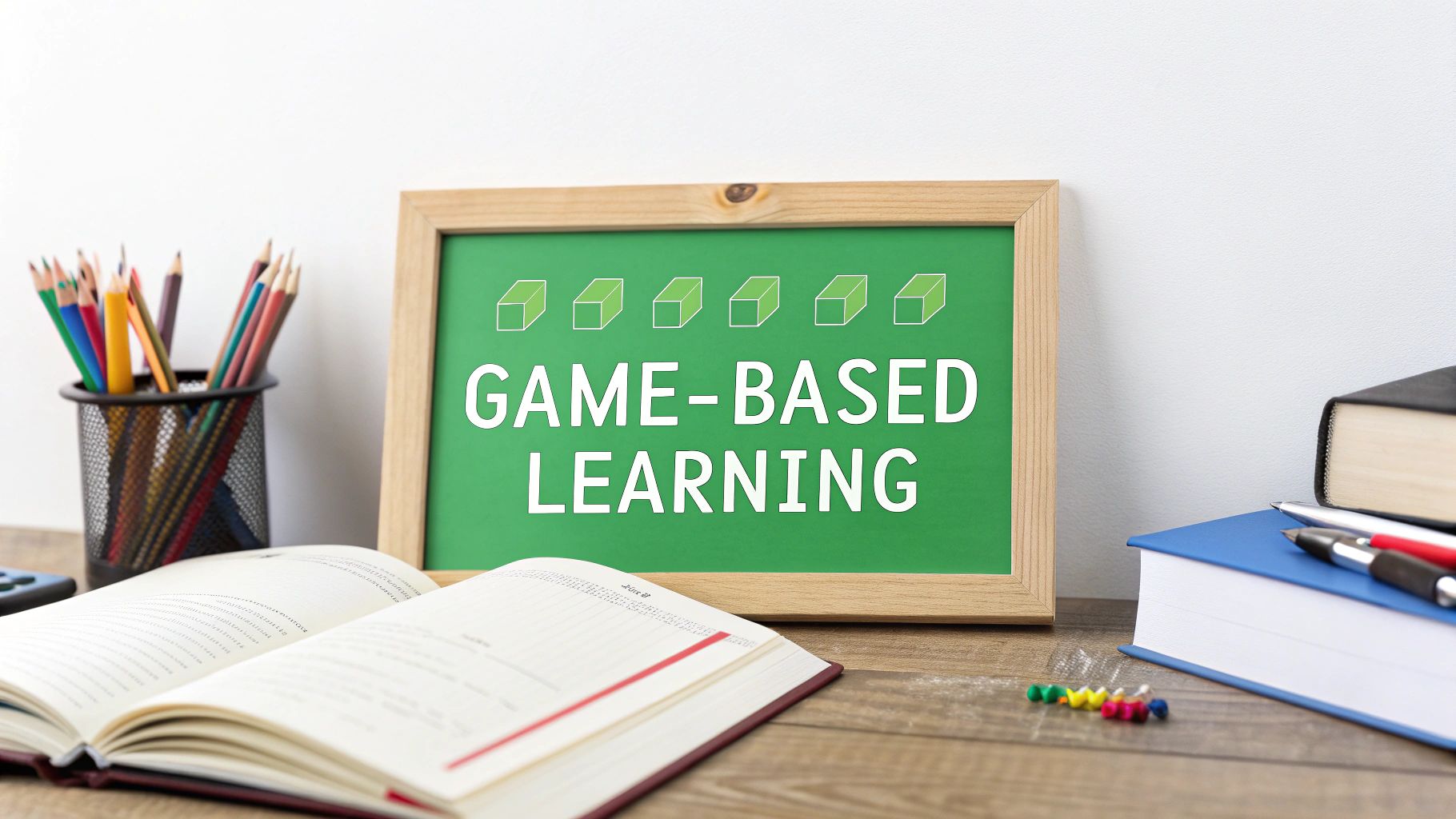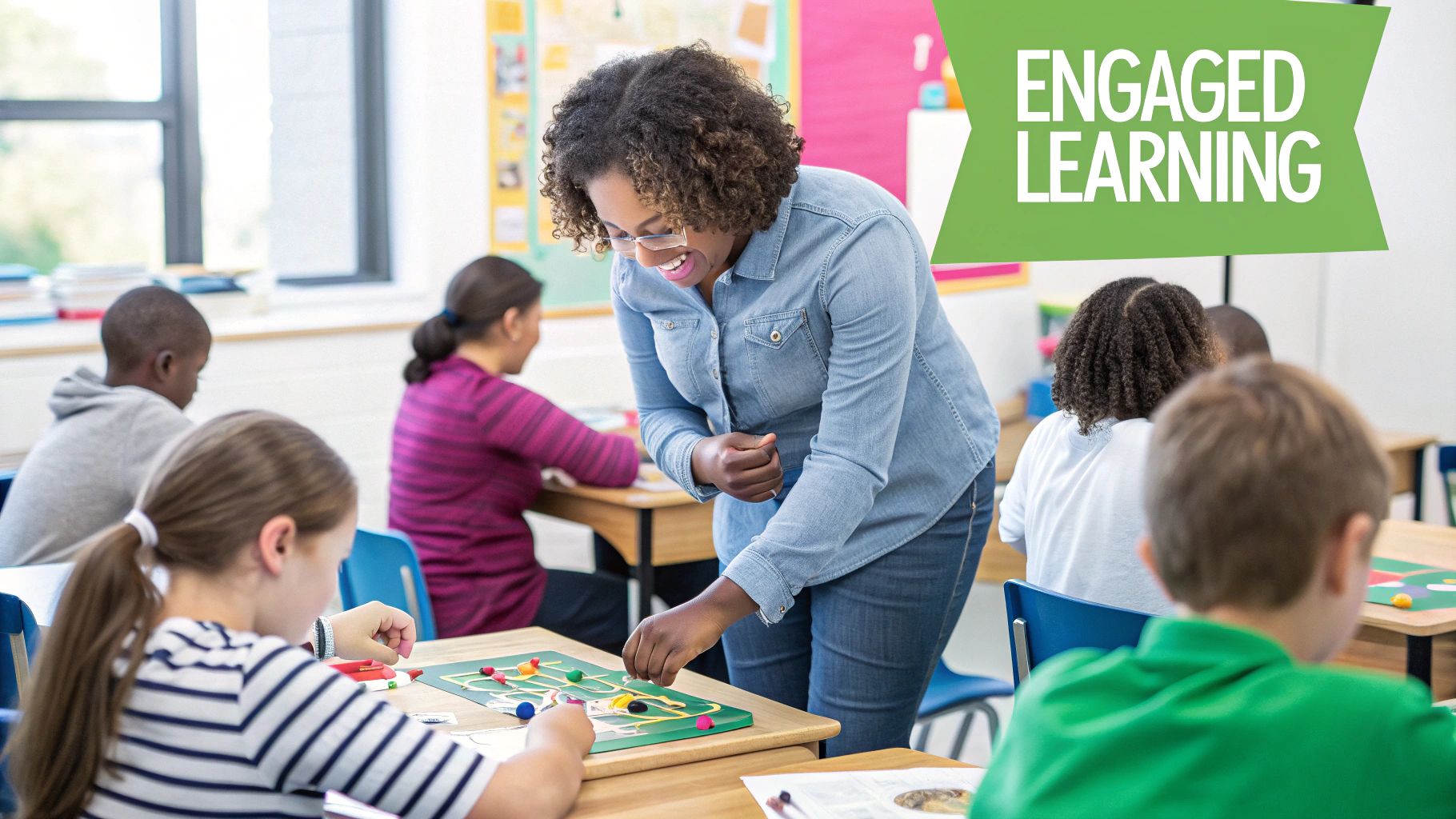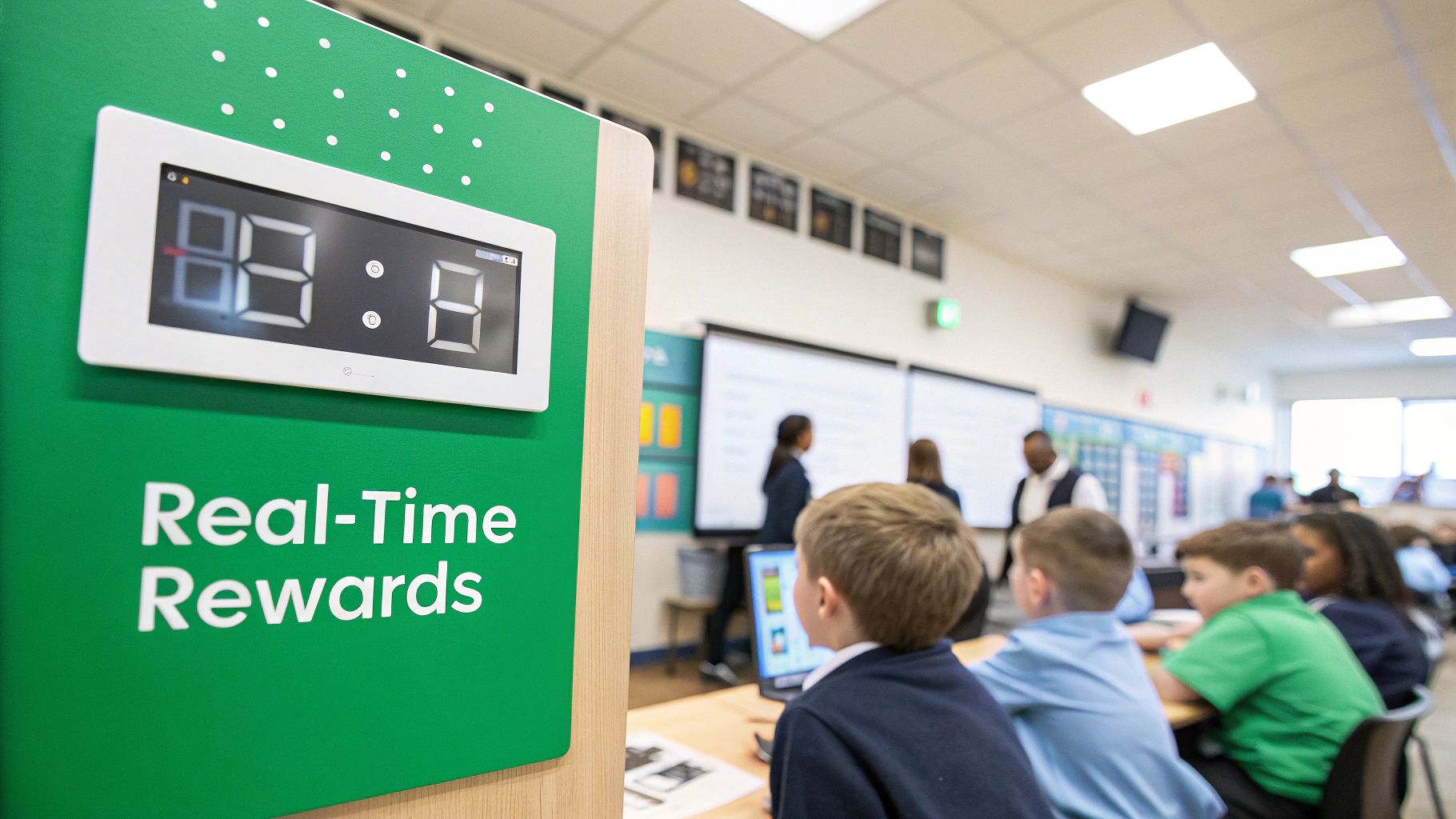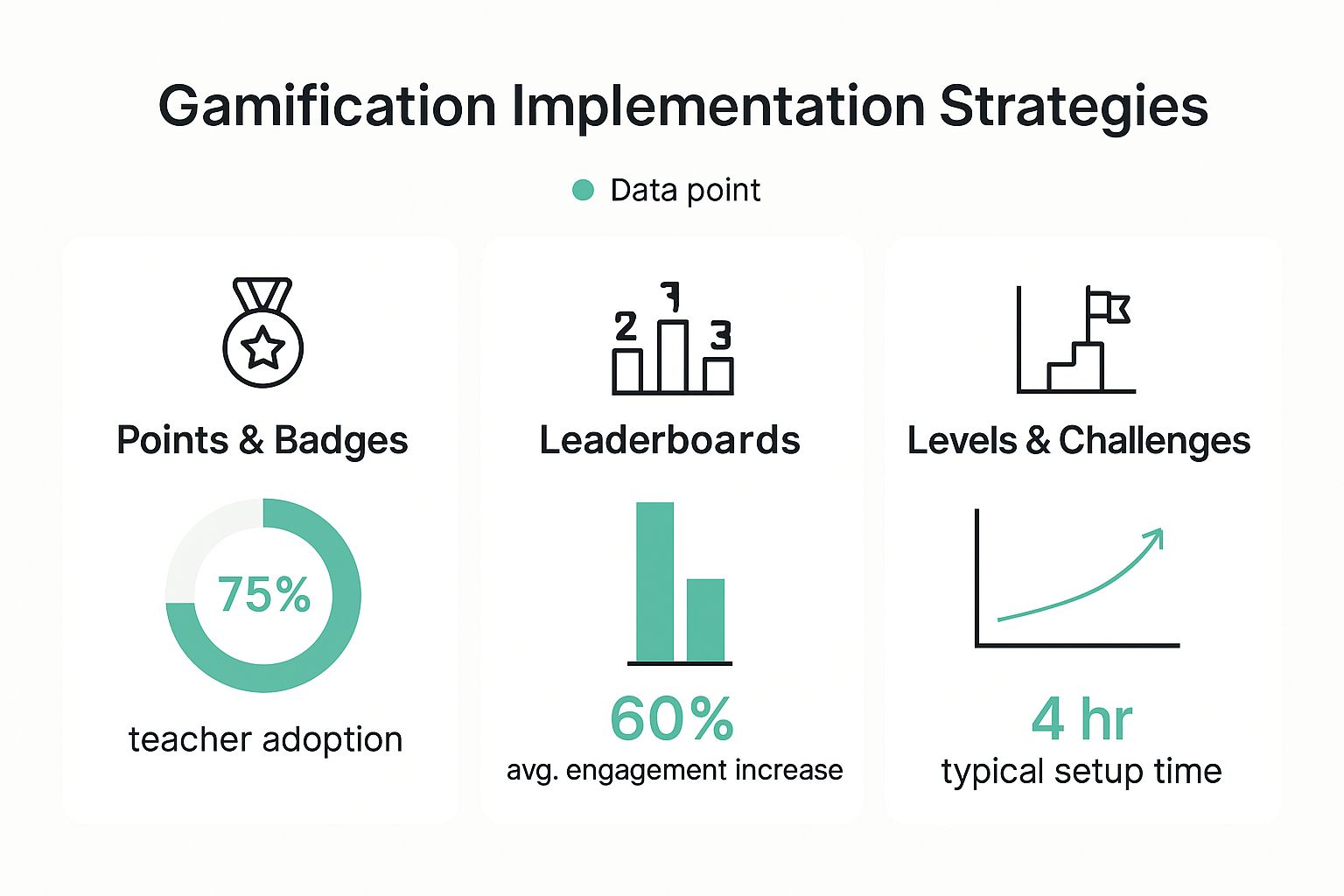What Is Gamification in Education and How It Works
Discover what is gamification in education and how it transforms learning. Explore proven strategies and real-world examples to boost student engagement.

So, what exactly is gamification in education?
At its heart, it’s all about applying the fun, engaging elements of games—like earning points, winning badges, or seeing your name on a leaderboard—to regular learning activities. It’s not about turning every lesson into a video game. Instead, it’s about borrowing the psychology that makes games so addictive to supercharge student motivation.
This simple shift transforms learning from a passive task into an exciting journey, tapping directly into our natural human desire for achievement, competition, and progress.
Decoding Gamification in the Classroom
Think about a fitness app that nudges you to keep going with streaks and rewards. Gamification does the exact same thing for a math lesson or a history project. The goal is to make the process of learning feel rewarding all on its own.
Instead of just slogging through a textbook chapter before a quiz, a student might embark on a "quest" to master the material. They could earn experience points (XP) for each section they complete. Finishing the whole chapter might unlock a unique badge that shows up on a class leaderboard, giving them a tangible sign of their hard work.

This kind of immediate feedback helps students actually see their progress, which is a massive motivator.
By framing learning as a series of fun challenges and rewarding students for their effort, gamification nurtures a growth mindset. The focus shifts from a fear of failing to the thrill of tackling the next obstacle and leveling up your skills.
This change in perspective is huge. It turns students from passive listeners into active participants who are genuinely driven to succeed. Education stops feeling like a chore and starts feeling like an adventure. The mechanics are simple, but the effect on student attitude is anything but.
To better understand how this works in practice, let's break down the core components.
The table below outlines the key elements of gamification, explaining what they are, why they work, and what they look like in a real classroom.
Gamification in Education at a Glance
| Component | Description | Example in a Classroom |
|---|---|---|
| Points & Rewards | Provides immediate, tangible feedback for completing tasks or demonstrating knowledge. This creates a satisfying loop of effort and reward. | Students earn 10 XP for each correct answer on a quiz or 50 XP for completing their homework on time. |
| Badges & Achievements | Visual symbols that represent mastery or the completion of a significant goal. They serve as public recognition of accomplishment. | A "Master Historian" badge is awarded for scoring above 90% on a history unit, or a "Creative Writer" badge for a well-written essay. |
| Leaderboards | A public ranking system that shows student progress relative to their peers. It introduces a friendly, competitive element. | A weekly leaderboard displays the top 5 students with the most points earned, resetting each week to give everyone a fresh start. |
| Narrative & Storytelling | Weaving academic content into a compelling story or theme. This gives context and a sense of purpose to learning activities. | A science unit on ecosystems is framed as a "Mission to Save the Rainforest," where each lesson helps students solve a new ecological problem. |
As you can see, these elements work together to create a dynamic and encouraging learning environment.
Key Elements That Drive Engagement
It’s the combination of these core components that makes gamified learning so powerful.
- Points and Rewards: These offer instant gratification and a clear way to measure progress, keeping students hooked.
- Badges and Achievements: These are visual trophies of mastery, giving students a real sense of accomplishment and status.
- Leaderboards: When used well, leaderboards can spark healthy competition and push students to do their best.
- Narratives and Storytelling: Wrapping lessons in a cool story gives them meaning and makes the information far more memorable.
These strategies are a perfect match for the principles of interactive learning, a topic we explore in our detailed guide. And it’s not just a niche idea—it’s a rapidly growing movement. The global gamification in education market is on track to hit USD 18.63 billion by 2033, which shows just how effective this approach is at boosting student engagement.
The Psychology Behind Gamified Learning
So, what is it about a simple progress bar or a digital badge that makes learning suddenly feel so compelling? The secret isn't in the graphics or the points themselves—it's in human psychology. Gamification in education is effective because it taps into the core drives that motivate us, shifting learning from a passive chore into an active, rewarding quest.
At its heart, gamified learning builds a powerful feedback loop. When a student answers a question correctly and instantly sees their score go up, their brain gets a tiny hit of dopamine. That’s the same chemical messenger linked to feelings of pleasure and reward. This creates a positive connection to the act of learning, making them want to do it again.
This system of immediate feedback and clear goals puts students in the driver's seat. It speaks directly to our universal need for mastery and a sense of accomplishment.
Tapping Into Intrinsic and Extrinsic Motivation
Gamification is so effective because it cleverly blends two different kinds of motivation to keep students hooked.
- Extrinsic Motivation: This is the drive that comes from outside rewards. Think points, badges, and climbing up a leaderboard. These are tangible, visible acknowledgments of effort and success, and they're great for getting things started.
- Intrinsic Motivation: This is the desire to do something just for the love of it—because it feels good or is personally satisfying. A well-designed game fosters this by giving students freedom, building their confidence, and letting them see their own skills improve.
A student might first jump in to earn a shiny new badge (extrinsic). But as they start mastering challenges and see their knowledge grow, that feeling of achievement becomes the real prize (intrinsic). This is the critical shift that helps create curious, lifelong learners.
The real magic happens when game mechanics aren't just used as rewards, but as tools that build a student's belief in their own abilities. Seeing a progress bar inch forward is visible proof of their effort paying off, which builds confidence and resilience.
Fostering Collaboration and Healthy Competition
But gamification isn't just a solo mission. It also plugs into our social nature to create a far more dynamic classroom.
Leaderboards can spark a bit of friendly competition, pushing students to try just a little harder. The best systems, however, balance this with teamwork. Imagine team-based quests where students have to pool their knowledge to solve a complex problem. These activities are fantastic for building communication and collaboration skills. For more ideas, check out our guide on how to engage students in learning.
This social, interactive approach really clicks with younger generations. With millennials expected to make up 75% of the global workforce by 2025, their preference for this style of engagement is a major reason gamification is taking off in education and beyond.
What Are the Real Benefits for Students and Educators?
Sure, gamification makes lessons more entertaining, but the real magic lies in the tangible advantages it delivers for both learners and teachers. It’s about more than just having fun—it fundamentally transforms the classroom by tapping into our natural drive for achievement, leading to deeper engagement and better learning.
One of the first things you'll notice is a huge jump in student participation. Traditional learning can often feel passive, but a gamified system turns students into active players in their own education. Quests, challenges, and point systems give them a compelling reason to dive in, pulling even the most hesitant learners into the action.

This hands-on approach directly boosts how well students remember what they learn. Instead of just reading and memorizing facts, they’re applying their knowledge through interactive tasks. In fact, some research shows that gamified learning can increase student achievement by nearly 90%. The simple act of earning rewards reinforces concepts through repetition and real application.
Building Critical Skills and Getting Instant Feedback
Beyond academics, gamification is a fantastic way to nurture the soft skills students need to succeed in the real world. Many gamified activities are designed to make students think critically and solve complex problems just to get to the next level. When teamwork is part of the design, these quests also build crucial collaboration and communication skills.
Think of a science unit framed as a "mission" to solve a planetary crisis. A team of students would have to pool their knowledge to overcome a challenge, which is exactly how things work in professional environments. Along the way, they learn that failure isn't a dead end—it's just a chance to regroup and try a new strategy.
Educators also get a huge leg up from the immediate feedback loops baked into these systems. A well-designed gamified platform delivers real-time data on student progress, quickly showing where individuals or even the whole class might be getting stuck.
This instant insight allows teachers to shift from being lecturers to becoming true learning facilitators. They can spot knowledge gaps as they happen and offer targeted help right when it's needed, creating a more personal and adaptive learning environment for every student.
This data-driven approach simply makes teaching more efficient and effective.
Key Advantages at a Glance
So, let's boil it down. The core benefits of bringing gamification into the classroom include:
- Increased Engagement: Game mechanics make learning more interactive and motivating, firing up active participation from everyone.
- Improved Knowledge Retention: The "learn by doing" model helps cement information far more effectively than just listening to a lecture.
- Skill Development: Gamified challenges naturally build critical thinking, problem-solving, and teamwork abilities.
- Instant Feedback: Both students and teachers get immediate data on performance, allowing for quick adjustments and personalized learning.
- A Safe Space to Fail: Gamification creates a low-stakes environment where students can experiment and learn from mistakes without the pressure of traditional grades.
When you put all these advantages together, you get a classroom that's more dynamic, responsive, and ultimately, far more successful for everyone involved.
Real-World Gamification Examples
Theory is one thing, but seeing gamification in action is what really makes the concept click. From apps used by millions worldwide to clever platforms for the classroom, real-world examples show just how powerful game mechanics can be for learning.
Let's look at some of the best ones out there.
One of the most famous examples has to be Duolingo. With over 300 million users, its success is built almost entirely on smart, simple game mechanics that make language learning feel less like a chore and more like a daily challenge.
- Streaks: The app tracks how many days in a row you practice. That little flame icon is surprisingly effective—the fear of "breaking the streak" keeps you coming back every day.
- Leaderboards: You're placed into weekly leagues, creating a bit of friendly competition. It’s a simple nudge to earn more points and climb to a higher division.
- Points and Rewards: You get experience points (XP) for every lesson you finish, which unlocks virtual currency to buy in-app goodies. It's a constant loop of positive reinforcement.
This mix of features turns what could be a tedious process into an addictive, habit-forming game.
Transforming Classroom Learning
It’s not just about consumer apps, either. Platforms are now giving teachers the tools to gamify their own curriculum. Imagine turning a standard history worksheet into a quest to unearth ancient artifacts, where every correct answer gets students one step closer to discovery.
This gives teachers the freedom to bring game mechanics to any subject. One math teacher in New Jersey, for instance, saw a 53% boost in student performance after framing lessons as "quests" and chapters as "unlockable levels." It’s a simple shift in perspective, but it reframes learning from a passive chore into an active, goal-driven adventure.
EarthChasers: Making Environmental Science an Adventure
A fantastic example of this done right is EarthChasers, a platform that transforms geography and environmental science into a stunning 3D adventure. It masterfully weaves educational content into game-like missions that genuinely spark curiosity. Instead of just reading about an ecosystem, students embark on missions to explore it firsthand.
Here’s a look at the EarthChasers interface, where students can select missions across the globe.

Right away, the visual design frames learning as an exploration, not a lecture. It invites you to dive in and see what you can find.
By presenting complex topics like biodiversity and climate change as missions with clear goals, points, and achievements, EarthChasers makes them feel accessible and exciting. Kids are driven to keep going because they want to unlock the next location or beat a community challenge. It’s a perfect illustration of how a great story and smart design can turn education into an unforgettable experience.
How to Start Using Gamification in Your Classroom
Ready to bring the power of play into your lessons? Getting started with gamification is more about smart planning than fancy tech. The most important first step is anchoring everything to a clear learning goal.
Before you even think about points or leaderboards, ask yourself one question: what specific concept do I want my students to master with this activity?
Once you have that goal locked in, you can pick the right game mechanic for the job. For instance, badges are fantastic for certifying that a student has mastered a unit. A timed leaderboard, on the other hand, can be a high-energy way to run a review session before a big test. This alignment is what makes gamification a learning tool, not just a distraction.
Begin With a Small Pilot Project
You don’t have to transform your entire curriculum overnight. That’s a recipe for burnout. Instead, start small.
Pick a single upcoming lesson or a short unit to pilot your first gamified activity. This lets you test what works with your specific students, get their feedback, and make tweaks without feeling overwhelmed. It’s a low-stakes way to find out what truly clicks.
This approach gives you invaluable, real-world data. Maybe your class thrives on collaborative quests but couldn't care less about individual high scores. A small test run tells you all you need to know.
This infographic breaks down some of the most common ways to get started.

While points and badges are easy entry points, the data shows leaderboards can give you a major boost in engagement when you use them thoughtfully.
Choose Your Tools Wisely
With your objectives set, it's time to find the tools to bring your ideas to life. This could be as simple as a sticker chart on the wall or as sophisticated as a dedicated software platform.
There are tons of great educational technology tools for teachers that can help you automate everything from awarding points to tracking progress.
But here’s a word of caution: a clear strategy is non-negotiable. It’s startling, but some studies show over 70% of gamification projects have failed. As Gamizign.com points out, these failures often happen because the goals were fuzzy or the design couldn't keep students interested long-term.
To make sure you're setting yourself up for success, it helps to consciously match the right game mechanic to your specific teaching goal.
Matching Game Mechanics to Learning Goals
This table offers a quick guide to help you choose the best element for the job.
| Learning Goal | Recommended Gamification Mechanic | Why It Works |
|---|---|---|
| Skill Mastery & Certification | Badges or Achievements | Provides a clear, tangible reward that signifies completion and competence in a specific area. |
| Repetitive Practice (e.g., math facts) | Points & Leaderboards (short-term) | Creates a fun, competitive environment that encourages quick, repeated attempts and improves speed and accuracy. |
| Completing a Multi-Step Project | Progress Bars & Levels | Visually shows students how far they’ve come and what’s next, breaking down a large task into manageable chunks. |
| Fostering Collaboration | Team Quests or Group Leaderboards | Encourages students to work together towards a shared goal, building communication and teamwork skills. |
| Encouraging Daily Habits (e.g., reading) | Streaks & Daily Rewards | Rewards consistency and helps build positive academic habits over time. |
Choosing the right mechanic isn't just about fun; it’s about intentionally designing an experience that reinforces the exact skill or behavior you want to see.
The key takeaway is that success isn't about the flashiest tools; it's about thoughtful design. A well-planned, low-tech system that aligns with your curriculum will always outperform a high-tech system that is disconnected from your learning goals. Start with your "why," then find the right "how."
The Future of Gamified Learning
Gamification in education has already made its mark, but what’s next on the horizon? The future isn’t just about adding more points and badges. It's about building deeply immersive and intelligent learning ecosystems, powered by some seriously cool new tech.
Think about a history lesson where students don’t just read about ancient Rome—they walk its streets in virtual reality (VR), completing quests by interacting with historical figures. Or picture a math problem that adjusts its difficulty on the fly, guided by an AI tutor that knows exactly when to push a student and when to lend a hand. This is the next frontier: a shift from simple game mechanics to truly personalized, adaptive experiences that fit each student’s unique learning style.
Smarter and More Connected Classrooms
The integration of artificial intelligence is going to be a complete game-changer. AI algorithms can dig into a student's performance data to map out custom learning paths, making sure the content is always a perfect match for their skill level. This keeps students in that "sweet spot" of learning, avoiding both boredom and frustration.
The future of educational gamification lies in its ability to be hyper-personalized. Instead of a one-size-fits-all game, learning will become a unique adventure for every student, guided by smart systems that understand their individual needs.
On top of that, cloud-based platforms are breaking down the physical walls of the classroom. These systems make it possible for students to team up on gamified projects and quests from anywhere, making collaborative learning truly remote-friendly.
This technological backbone is what will make it all possible. In fact, North America currently holds a 40% share of the gamification education market, a lead that’s largely thanks to its strong tech infrastructure and investment. You can find more insights on the gamification education market over at marketdataforecast.com. The rise of cloud solutions will only accelerate this growth, making powerful learning tools more accessible than ever.
Ultimately, the future of gamification is more than just a fleeting trend. It’s a fundamental shift toward an educational model that is more engaging, more responsive, and a whole lot more effective for every single learner.
Your Gamification Questions, Answered
As gamification becomes a bigger part of the classroom, it's natural for teachers and parents to have questions. Let's tackle some of the most common ones to get a clearer picture of how this all works.
Is Gamification Just Playing Games in Class?
Not even close. This is probably the biggest misconception out there. Gamification isn’t about replacing a history lesson with a video game.
It's about borrowing the smart, motivating parts of games—like points, quests, and progress bars—and applying them to the learning material itself. The goal is to tap into the same psychology that makes games so compelling to make the core learning process more engaging.
Does Gamification Work for All Age Groups?
Absolutely, but you can't use a one-size-fits-all approach. For younger kids, simple rewards like digital stickers or colorful badges provide that instant, positive feedback they thrive on.
As students get older, the strategy needs to mature with them. High schoolers and adult learners respond better to narrative-driven projects, skill-based leaderboards that reward mastery (not just speed), and complex challenges that demand real critical thinking. The key is to match the mechanic to the learner's mindset.
The core idea is the same for every age: make progress visible and reward the effort. This simple loop builds confidence and creates a positive association with learning, whether it's in first grade or a university lecture hall.
Can It Create Unhealthy Competition?
It can, but only if it's poorly designed. A well-thought-out gamification strategy is about so much more than a simple leaderboard showing who’s in first place.
The best systems weave in collaborative elements, like team-based quests or shared class goals. This shifts the focus from "me vs. you" to "us vs. the challenge," teaching students how to work together and celebrate group success. Done right, it builds a supportive community where everyone is pushing each other to get better.
Ready to see how a well-designed gamified experience can transform learning? Explore the world with EarthChasers and turn geography into an unforgettable adventure. Discover our missions today.
